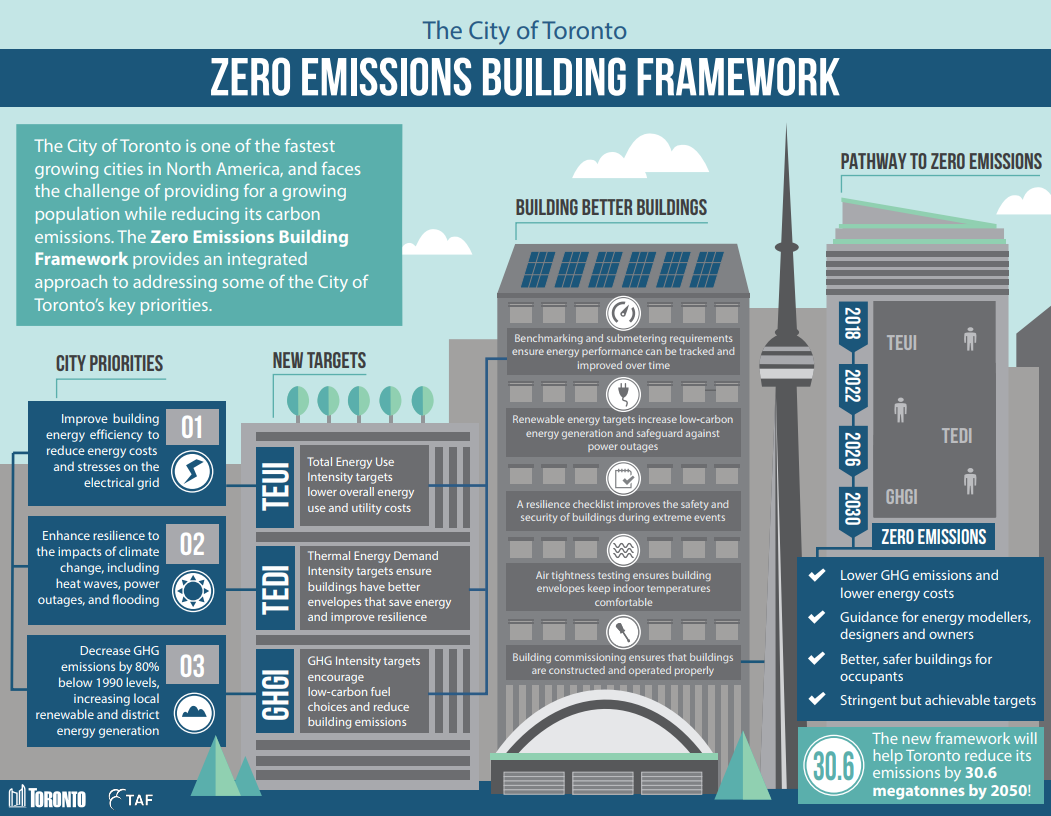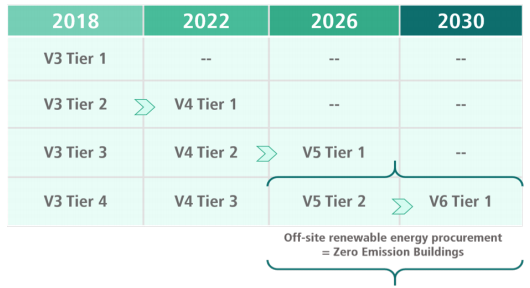As Toronto continues to grow in leaps and bounds, it’s imperative to get emissions from new construction under control if we want to reach our 2050 climate target. That’s why one of the key commitments in the Transform TO climate plan is achieving near zero emissions in all new buildings by 2030. We’re about to get closer to this goal as a new building policy, the Toronto Green Standard 3.0, has been approved by City Council.
Just how important is the near zero goal? While retrofitting existing homes and buildings is a big priority as well, Toronto’s population is projected to grow by over 35 per cent by 2050. That means a massive build-out of residential and commercial real-estate that must be highly energy efficient. If built to current standards, these future buildings would consume Toronto’s entire 2050 carbon budget!
Thankfully, Toronto is about to take a big step towards delivering on its near zero emissions commitment with the adoption of version 3 of the Toronto Green Standard (TGS). It’s a set of sustainable design standards which applies to all new developments that require planning approvals in Toronto. TGS began as a voluntary standard in 2006, became mandatory in 2010, and was updated in 2014. The Atmospheric Fund (TAF) helped design all three versions as a long-term partner of Toronto City Planning.
These building standards are not just about reducing carbon emissions; they also make Toronto’s buildings more resilient, more comfortable, and more affordable with lower energy costs.

To strengthen the 2014 standards even further, TAF and the City began with a global review of best practices in energy and carbon standards for new construction. This quickly identified two priorities for Toronto:
- Develop a long-term vision and goals to guide the evolution of the standard and provide clear direction to industry; and
- Transition to the use of performance targets directly related to core objectives.
Strangely enough, both of these best practices are radical departures from the history and current practice of energy performance standards in North America (more on this in a future blog post).
Working in partnership with the environmental consulting firm Integral and a stakeholder advisory group, TAF and City Planning developed a Zero Emissions Building Framework for the City of Toronto. Drawing on best practices from around the world, the framework is based on a set of three performance targets, outlined below:
- Thermal Energy Demand Intensity targets ensure buildings have better envelopes (i.e. walls, windows, and roofs), producing long-lasting energy savings and enhancing resiliency by extending the length of time buildings can remain habitable during power outages or HVAC system failures.
- Energy Use Intensity targets ensure lower overall energy use and utility costs across all building systems.
- Greenhouse Gas Intensity targets encourage the use of lower carbon fuels while allowing flexibility to use natural gas as long as the total GHGI target is achieved. Since the policy priority is achieving near zero emissions, these targets are absolutely critical.
This trio of performance targets also enables the creation of a road map to the City’s 2030 near zero emissions goal. Using these three performance metrics, we started by defining precisely what near zero emissions means for Toronto. We then worked backward to create interim performance targets for 2026, 2022, and 2018. This resulted in four tiers of performance: Tier 1 is the proposed mandatory design target for all new buildings beginning May 2018, while Tiers 2, 3 and 4 are voluntary stretch targets with a financial incentive for those willing to meet them. The idea is that every four years, we eliminate the lowest Tier, until Tier 4 – near zero emissions – becomes the mandatory design target in 2030.
With a series of targets and a clear timetable in place, the buildings industry will have the regulatory certainty it needs to focus on optimizing the technologies and design approaches needed to cost-effectively deliver a low carbon future.
TGS 3.0 — including all four tiers of the Zero Emissions Building Framework — was approved by the City of Toronto’s Planning and Growth Management Committee on October 12. It was approved by City Council on December 7, with implementation slated for May 2018.
Much more work remains to be done, but approval of TGS 3.0 means putting in place the first major policy to deliver on the TransformTO climate plan and turn Toronto into a low-carbon city.
Note: This blog post was updated to reflect the December 7 City Council vote that approved TGS 3.0.


